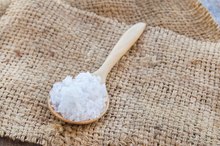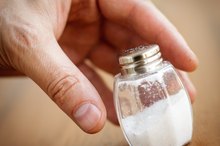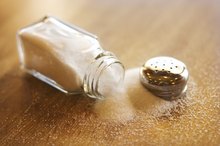What does fact checked mean?
At Healthfully, we strive to deliver objective content that is accurate and up-to-date. Our team periodically reviews articles in order to ensure content quality. The sources cited below consist of evidence from peer-reviewed journals, prominent medical organizations, academic associations, and government data.
The information contained on this site is for informational purposes only, and should not be used as a substitute for the advice of a professional health care provider. Please check with the appropriate physician regarding health questions and concerns. Although we strive to deliver accurate and up-to-date information, no guarantee to that effect is made.
What Causes a Soapy Taste in the Mouth?
Unusual tastes in the mouth can be irritating. They can be the result of a number of things: changing toothpaste products used in the home, eating an exotic meal or spices, or even medication use. But some unusual tastes in the mouth are the result of poisoning, so it is important to better understand why you might be having unusual tastes in the mouth. For example, a soapy taste in the mouth could be the result of ingesting too much fluoride (sodium fluoride), which can be poisonous to your health according to the Center for Disease Control.
Sodium fluoride defined
If you look up the definition of sodium fluoride on general medical websites you might find a reference to the fluoridation of water within the definition, as well as support of its use in preventing tooth decay. However, Miriam-Webster Dictionary provides a more chilling definition of sodium fluoride: "a poisonous crystalline salt (NaF) that is used in trace amounts of the fluoridation of drinking water and toothpastes, in metallurgy, as a flux, and as a pesticide. 2"
For those who have assumed that fluoride in toothpastes and tap water is a good thing, Miriam's definition gives great pause, as it expressly states that "trace amounts only" are expected to be present in drinking water and toothpaste. In addition, it states that sodium fluoride is used in pesticides and it is considered poisonous, most definitely when ingested in large quantities.
But what does sodium fluoride have to do with having a soapy taste in the mouth? Quite a bit, actually, since that soapy taste can indicate that you have ingested too much sodium fluoride and are now at risk for more severe health symptoms.
- If you look up the definition of sodium fluoride on general medical websites you might find a reference to the fluoridation of water within the definition, as well as support of its use in preventing tooth decay.
Center for Disease Control (CDC)
Can Swishing Salt Water in the Mouth Raise Blood Pressure?
Learn More
The Center for Disease Control (CDC), whose headquarters is located in Atlanta, Georgia, warns against sodium fluoride poisoning and cautions that one of the symptoms of this type of poisoning is a soapy taste in the mouth 1. According to the CDC, a soapy taste in the mouth can be the first indicator of sodium fluoride poisoning. Sometimes this soapy taste is also joined by a salty taste as well, due to the sodium component of this crystalline salt.
But a soapy taste in your mouth isn't going to be your only problem if it is the result of sodium fluoride poisoning. Additional - and more severe - symptoms generally follow for those who have ingested too much sodium fluoride: collapse, shock, numbness of mouth, vomiting, diarrhea, dilated pupils and pallor.
- The Center for Disease Control (CDC), whose headquarters is located in Atlanta, Georgia, warns against sodium fluoride poisoning and cautions that one of the symptoms of this type of poisoning is a soapy taste in the mouth 1.
Other sources of sodium fluoride in the home
In addition to the most common means of sodium fluoride poisoning (drinking tap water with too much fluoridation in it, receiving too many fluoride treatments at the dental office, or a combination of the two), sodium fluoride poisoning is also a result of contaminated dry foods: dry milk, flour, baking powder, and even cake mixes. These dry foods may contain insecticides or rodenticides found in the sodium fluoride, posing a health danger.
Diagnosis
Sodium and Puffy Eyes
Learn More
According to the CDC, laboratory testing should be done on vomitus or gastric washings if the aforementioned severe symptoms are present (collapse, shock, vomiting, diarrhea, etc.). This testing will aid in the detection and diagnosis of sodium fluoride poisoning.
This particular medical condition is not contagious, but testing will help you to properly label the reason for your symptoms and aid in preventing another occurrence, since you can take steps to eliminate this chemical in your home and body in the future.
Treatment
If a mild soapy taste is present, but the other symptoms mentioned above are not, you may be able to head off a more serious case of sodium fluoride poisoning - and put an end to your soapy mouth taste - by yourself, without aid of a doctor. You might be able to do this by simply reducing the amount you drink of tap water each day (or having your tap water checked for fluoridation levels, which may need to be reduced by your water company).
In addition, reducing your in-home or dental office fluoride treatment product use would be a wise option (after you discuss it with your dentist, of course), as would choosing to use a toothpaste that does not contain as much sodium fluoride.
There are no specific at-home treatment options given by the CDC for those suffering from a soapy mouth due to sodium fluoride poisoning. Elimination of this chemical from your home and diet would be a logical conclusion, though. But if you or someone you know begins to suffer the more severe symptoms described above (shock, collapse, mouth numbness), someone would need to seek professional medical attention on behalf of that person.
- If a mild soapy taste is present, but the other symptoms mentioned above are not, you may be able to head off a more serious case of sodium fluoride poisoning - and put an end to your soapy mouth taste - by yourself, without aid of a doctor.
- In addition, reducing your in-home or dental office fluoride treatment product use would be a wise option (after you discuss it with your dentist, of course), as would choosing to use a toothpaste that does not contain as much sodium fluoride.
Related Articles
References
- Center for Disease Control: Diagnosis and Management of Foodborne Illnesses
- Miriam Webster On-line Dictionary
- Aoun A, Darwiche F, Al Hayek S, Doumit J. The Fluoride Debate: The Pros and Cons of Fluoridation. Prev Nutr Food Sci. 2018 Sep;23(3):171-180. doi: 10.3746/pnf.2018.23.3.171. Epub 2018 Sep 30.
- Cheng X, Liu J, Li J, Zhou X, Wang L, Liu J, Xu X. Comparative effect of a stannous fluoride toothpaste and a sodium fluoride toothpaste on a multispecies biofilm. Arch Oral Biol. 2017 Feb;74:5-11. doi: 10.1016/j.archoralbio.2016.10.030. Epub 2016 Oct 29.
- Lv YG, Kang L, Wu G. Fluorosis increases the risk of postmenopausal osteoporosis by stimulating interferon γ. Biochem Biophys Res Commun. 2016 Oct 14;479(2):372-379. doi: 10.1016/j.bbrc.2016.09.083. Epub 2016 Sep 17.
- Peckham S, Lowery D, Spencer S. Are fluoride levels in drinking water associated with hypothyroidism prevalence in England? A large observational study of GP practice data and fluoride levels in drinking water. J Epidemiol Community Health. 2015 Jul;69(7):619-24. doi: 10.1136/jech-2014-204971. Epub 2015 Feb 24.
- Pornprasert S, Wanachantararak P, Kantawong F et al. Excessive fluoride consumption increases haematological alteration in subjects with iron deficiency, thalassaemia, and glucose-6-phosphate dehydrogenase (G-6-PD) deficiency. Environ Geochem Health. 2017 Aug;39(4):751-758. doi: 10.1007/s10653-016-9845-x. Epub 2016 Jun 18.
Writer Bio
Holly Huntington's writing has been published online by eHow.









